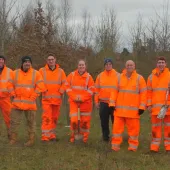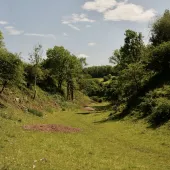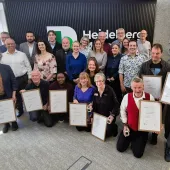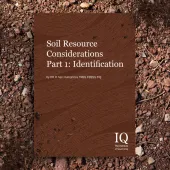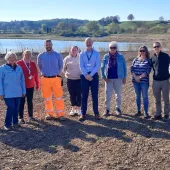The Biodiversity Metric 3.0 and Minerals
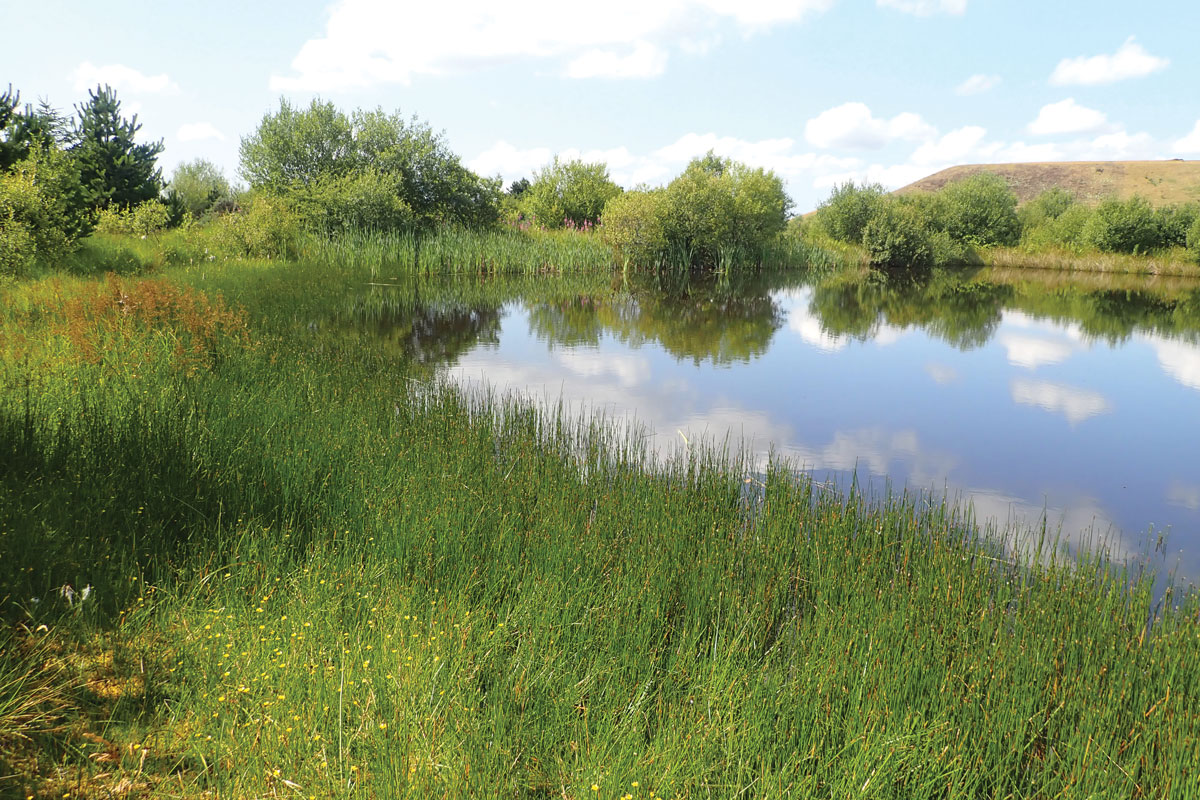
First published in the September 2021 issue of Quarry Management
Opportunities, constraints and possible consequences for the industry
By Dr R.N. Humphries FIQ, Blakemere Consultants Ltd and Celtic Energy Ltd
Within the provisions of the Environmental Bill[1] currently going through Parliament, compensation will be legally required in future for the loss of habitats due to developments. It is anticipated that at least a 10% net gain could be mandated. To assist in the quantification an algorithm has been developed. Currently, this is manifest as the Biodiversity Metric 3.0[2], which calculates the pre-development biodiversity value of a site, the value following interventions such as habitat creation and enhancement, and the resulting net gain or loss.
Since the prospect first arose, the minerals industry, through individuals and trade associations, has questioned its applicability and voiced its concern that it will result in the opposite outcome of less wildlife than intended[3]. It is understood that it remains Defra’s and Natural England’s intention to apply the Metric to mineral extraction sites despite there being a long-established and effective planning control process whereby mineral sites have contributed significantly to the recovery of UK’s biodiversity at local, regional and national levels.
The purpose of this article is to examine some of the opportunities and constraints resulting from the simple mechanical application of Metric 3.0 and the possible consequences for the industry. To illustrate the author’s key points and for brevity, only terrestrial areal habitats are referred to.
The mechanical computations
The Metric operates by integrating simple arithmetic scores ascribed to three habitat attributes chosen as surrogates for biodiversity value (expressed as habitat units) of the features recorded within a site; this provides a baseline prior to development. The factors used are the ‘distinctiveness’ (ie the relative importance of the UK Habitat Classification type[4]), its ‘condition’ and its local ‘strategic significance’. The calculation of the units is repeated for the post-development situation involving both within- and off-site habitat creation and enhancement interventions. This involves a set of multipliers that enhance or discount the value of the units according to the level of risks for the ‘difficulty of creation’ and ‘temporal’ (time) dimension for delivery of the interventions. The simple difference between the sum of the post-development and the baseline determines whether there is a net gain, balance or loss in biodiversity units.
The basis and the workings of the Metric and the key principles to be applied are fully explained in the User Guide and Technical Supplement for Metric 3.0[2]. Whilst there have been changes between versions 2.0 and 3.0 with the ‘habitat connectivity’ function being disabled and the addition of a multiplier rewarding the pre-development delivery of the compensatory interventions, the basis for the calculations is unchanged.
Habitat distinctiveness determines options
Habitat distinctiveness is the most important determinant of the outcomes of applying the Metric. Not only does it govern the amount of ‘difficulty’ and ‘temporal’ discounts to be applied to the compensating habitat units, but it also governs the compensation options available by the application of a number of ‘game rules’ whereby biodiversity gain (as habitat units) is to be achieved.
There are four categories of distinctiveness, Very High, High, Medium and Low. For Low-category habitats the Metric allows the minimum compensation to be of the same category in a better condition, but it does not need to be the same type of habitat. A Medium category is to be compensated by the same category of habitat or a higher category (ie High or Very High), whereas those in the High category must be replaced or enhanced by the same habitat. Whilst for these three categories replacement and enhancement may be allowed for a loss of habitats, provided there is sufficient compensation in terms of the number of biodiversity units delivered, this scope is not available for the Very High category, even though the same arithmetic calculation is used as for the lower categories. Here, a policy/political rule is applied where the model states ‘no loss is acceptable’ and ‘bespoke compensation’ is likely but is not quantified.
Whilst ancient woodland, old orchards and parkland/wood-pastures are only categorized as High-value habitats, despite being assigned multipliers within the algorithm, in the supporting Metric database they are regarded as not creatable.
Compensation needed to achieve net gain
Given the quantum of net gain is likely to be 10% whatever the habitat category, it might be expected that for an area of 10ha of habitat lost, an additional 1ha is to be created or enhanced. In most cases this will not be so, given the weighted multipliers for the different habitat categories and the trading rules governing their compensation and differential discounts for assumed difficulties in habitat creation and estimates of the time before the perceived biodiversity benefits are realized.
Because the algorithm discounts the biodiversity units credited as a result of the ascribed relative difficulty in habitat creation and the notional time before they attain the target biodiversity value, the algorithm is biased toward requiring a greater area of habitat compensation to be provided than is lost. The scale of this depends on the habitat category involved and its condition. It may only provide net gain in the Low and Medium categories by the election to create a higher level of habitat. For example, the need for additional land by the loss of good-condition Low-category habitat might be compensated by the creation of Medium or High habitat. In the case of the loss of High-category habitat, the same habitat is the only option and this, by default, requires additional area that might be beyond the extent of the site. For the Very High category, the requirement is unquantified as the Metric in effect places an embargo on the working of such areas. The differential scale of the replacement habitat with a 10% net gain is illustrated below.
Sites with Low-value habitats
For those habitats (Table 1 and fig. 1) which are inherently of low biodiversity value, such as agricultural grassland leys, the calculated like-for-like compensation with at 10% net gain for a loss of 10ha of good-condition grassland would be an additional 5ha (15ha in total) or 2ha (12ha in total) if it were in a poor condition. Should the restoration be delayed, eg for 10 years to facilitate the working of the minerals and site restoration, the additional grassland habitat to be provided would be 11ha (21ha in total) owing to the Metric’s temporal discount. However, if equivalent good-condition grassland was created in advance, eg 20 years ahead of its loss, only 1ha (11ha total) of additional grassland would be required to provide the 10% net gain.
The protocol for Low-category habitats also enables the option for higher-valued habitats to be created. Should the restoration comprise 3ha of Low-category grassland ley habitat and 7ha of temporary lakes, ponds and pools of the High category, with both either being in a poor or a good condition, a 22% or 60% net gain, respectively, can be provided within the 10ha site.
Sites with Medium-value habitats
For Medium-category habitats (Table 1 and fig. 2) the compensation trading rules also allow for the simple option of an improvement in condition of like-for-like habitat category, but not the down-trading of a category. There is also the option of a higher habitat category. The main change in the algorithm is a larger discount for delays in delivering the restoration scheme, but the general outcome of the computation is generally similar to the Low category of habitats, and where higher-category habitats are restored, net gain can be provided without additional land.
Sites with High-value habitats
High-category habitats (Table 1 and fig 3) can only be compensated by the same habitat type. For 10ha of good-condition or poor-condition upland calcareous grassland 82ha (92ha in total) and 48ha (58ha in total) of replacement on restoration are required to provide an 11% net gain. Should the restoration be delayed for 10 years the quantum required for good-condition grassland rises to 105ha (115ha in total) to provide a 11% net gain, but this is only reduced to 40ha (50ha in total) to achieve the 11% net gain if compensation was possible in advance.
Sites with Very High-value habitats
Whilst the Metric will calculate the habitat units to be created on restoration, it does not recognize the baseline habitat value for the Very High category of habitats (Table 1 and fig. 4), hence the quantum required for a net gain is not computed. Given the greater value of the habitats ascribed to this category, it implies either a greater quantum of compensation than for those in the High category or that it is not possible to do so.
Consequence for mineral extraction
What might this mean for the mineral extraction industry?
For sites with low and moderate biodiversity potentials the Metric simply drives the incentive for a net gain in biodiversity through the diversification of habitat types. The types of flower-rich grasslands, diverse scrub and woodland, and wetland habitats currently being created by the industry should, for most of these sites, deliver the required biodiversity net gain using the Metric. Here, contrary to some views, the application of the Metric should not normally be of concern. For these sites the Metric should not normally result in less biodiversity than is currently being delivered by the mineral industry, neither should it inhibit the working of the associated mineral resources nor require undue additional land resources or investment.
The Metric involving the High category of habitats also drives net gain with the incentive for their specific recovery. The consequence for the mineral industry is that the Metric may inhibit the development of some mineral resources that are not of strategic importance, as the delivery of biodiversity net gain may not be feasible and/or may require considerable long-term planning and investment.
Delivery of the required extensive additional areas of specific habitats in the High category will be a considerable challenge for the mineral industry and may only be achievable through the combination of both within- and off-site compensation involving habitat creation and/or enhancement elsewhere. This, in many circumstances, could contribute to the wider government biodiversity recovery plan[5]. Importantly for the industry, for those mineral resources located beneath the High-category habitats, this will require greater strategic planning and knowledge of the coincidental biodiversity and investment needed. Hence, there could be implications for greater operational costs and higher mineral prices.
In the case of the Very High category encompassing habitats such as limestone pavements, peatland and aquifers, the incentive is clearly not to work the mineral resources. This is of no surprise and has largely been an accepted constraint for many years through the existing legislation and policies. There may be less of a case for some of the Very High-category habitats, such as lowland and hay meadows, which might be reassessed as High-category habitats.
An industry-specific Metric?
The Metric is simply a semi-quantitative conceptualized model as a means of providing guidance as to the opportunity for biodiversity gain through habitat creation and enhancement. It does not pretend to be a definitive and accurate measure of biodiversity value or its delivery. The Metric originated as a means of estimating the scope for and costs of the wider UK biodiversity recovery programme and relies on the published and expert evidence relevant to that exercise[5], and notably not that of the particular experience and context of the minerals industry[6].
However, there is an opportunity for the industry to adapt the Metric to its circumstances. Access to the numerical model within the Metric is offered by Natural England to users so they can substitute their alternative data sets, such as the values for habitat categories and types, discounts for the difficulty of creation and the time to deliver benefit. Of course, the deployment of an industry-derived Metric would need to be accepted by Defra and Natural England.
With the current Metric the difficulty of creation of habitats is weighted as to the intervention required on undisturbed land. For example, if the habitat can be created by simply abandoning land it is considered to be of a low difficulty and is subject to a multiplier of 1 (ie no reduction in the notional habitat area created), but if engineering works are required for the habitat it is weighted by a multiplier of 0.33 (ie a 67% reduction in the credit for the area of habitat actually created). For habitats in the High category this is significant and results in the need for a greater area to be created than expected. Engineering works are part and parcel of mineral working restoration and provided the necessary soil and plant materials are available and conditions are creatable, the level of difficulty is likely to be substantially lower and may only justify a multiplier of 1. For example, reed beds are ascribed as medium difficulty and incur a 0.67 multiplier (ie a 33% reduction in extent), but in mineral workings they are amongst the easiest to create and should only have an x1 weighting (ie no reduction in the credit for created habitat). The Very High-category purple moor grass and rush pasture habitats are ascribed in the Metric as having a high technical difficulty owing to complex hydrological requirements and are given a multiplier of 0.33. However, this is not the experience in mineral site restorations as the hydrological conditions are well understood and re-creatable, so a neutral weighting of x1 is justified (ie there is no discounting of the area of habitat created).
The discounting of habitat created by the ascribed time to deliver the biodiversity benefit is another factor that influences the amount of compensation required for a net gain. The aspired condition of the created habitat, whether good, moderate or poor, is another where the election of good and moderate conditions is discounted as they are programmed to require a longer period of time to reach the target condition. Both result in a greater area to be created than would be expected. Unlike the premise underlying the origin of the Metric’s time-based multiplier, mineral workings can facilitate quicker recovery through the conservation of soil materials and the provision of conducive conditions. For example, the Metric ascribes a period of 30 years for good-condition upland heathland and applies a multiplier of 0.34 (discounting the credit for area created by 66%) and 10 years for poor condition with a multiplier of 0.7 (a discount of 30%). Yet, through the conservation and reuse of the soil resources, good condition heathland is possible within five to 10 years. By the time 30 years is reached the heathland will probably be in a poor condition having reached an over-mature life cycle stage. Similarly, blanket bog and other peatlands of the Very High habitat category can be created through the working of minerals. The projected time scales of more than 30 years for good condition (with a discount multiplier of 0.32) and 15 years for poor condition (discount multiplier of 0.58) are greater than actual experience where good-condition habitat can be created within five to seven years.
With the enhanced opportunities for habitat creation resulting from mineral extraction and the experienced gained, there is an irrefutable case for industry-based multipliers to be adopted in a minerals version of the Metric. As the author has pointed out before[7], the industry can help itself by the collection and collation of its own data sets. The consequence for the industry is that it could be closer to achieving the simple 10% of unit habitat gain without onerous provisions for substantial additional resources, whilst allowing mineral resources to be released that otherwise could be inhibited from development.
Perverse outcome?
Will the Metric result in a perverse outcome as suggested[3]? Probably less than feared, and certainly so if the Metric can be populated with industry data; something that should be a priority in the anticipated discussion with Defra and Natural England.
For most situations where mineral extraction affects habitats of Low and Medium biodiversity value it should be business as usual. For those operations involving habitats of High and Very High value, these are already highly scrutinized by means of the Environmental Impact[8] and planning consent processes[9] where a balance is drawn between the need for the mineral and the environmental damage caused, along with the scope for compensating habitat creation and enhancement. In these cases, the Metric simply adds to the incentive to locate mineral extraction away from important biodiversity assets and those identified in the National Recovery programme; something that already takes place as a result of the planning system.
Clearly, the implications of the Metric are of wider consequence than for individual operating companies and warrant a national oversight involving both government and industry bodies to ensure the unimpeded supply of minerals – something that the British Geological Survey might take a leading role in? There then could be more surety of the integration of the exploitation of mineral assets with the Government’s planned recovery of the UK’s biodiversity. Perhaps there could be an industry-wide scheme contributing to its national funding whereby any onerous requirements of the Metric are removed?
All of the habitats shown in the images are on restored land after mineral working.
REFERENCES
- UK Parliament, 2021. Environment Bill (as amended in Committee, July 2021). https://bills.parliament.uk/publications/42243/documents/555
- Natural England, 2021. The Biodiversity Metric 3.0 (JP039). http://publications.naturalengland.org.uk/publication/6049804846366720
- Anon, 2021. MPA asks DEFRA to ‘think again’ on Biodiversity Metric. Quarry Management, August 2021, p6.
- UKHab, 2020. UK Habitats Classification. https://ukhab.org/
- Natural England, 2016. Developing Datasets for Biodiversity 2020: Outcome 1D (Omnicom 24951/ITT455) (NERC214). http://publications.naturalengland.org.uk/publication/5109098148790272
- HUMPHRIES R.N.: ‘Biodiversity: Curse or Opportunity?’ Mining Quarrying & Recycling, 2000/2001, Vol 29, 10, pp2-29 and Vol 30, 1, pp33-37.
- HUMPHRIES R.N. and R. THOMPSON: ‘Evidence-Based Restoration – Responding to the Challenges, Quarry Management, May 2014, pp39-44.
- CARROL B., FOTHERGILL J., MURPHY J. and T. Turpin: Environmental Impact Assessment Handbook, 2020, ICE Publishing, London.
- Ministry of Housing, Communities & Local Government, 2021, National Planning Policy Framework. https://assets.publishing.service.gov.uk/government/uploads/system/uploads/attachment_data/file/1005759/NPPF_July_2021.pdf
Subscribe to Quarry Management, the monthly journal for the mineral products industry, to read articles before they appear on Agg-Net.com


